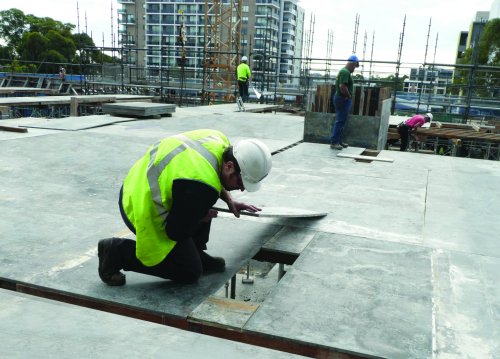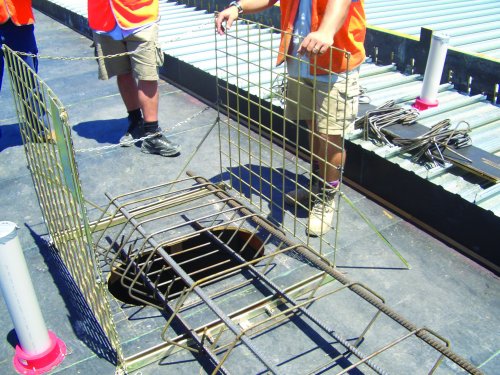Preventing falls on construction sites
Friday, 01 July, 2011
Too many people who work on construction sites think that it’s someone else’s responsibility to keep them safe. This is especially true for people who are required to work at height in these environments. But even the most conscientious and safety-focused worker can pay the ultimate price due to workplace safety neglect.

In July 2006, supervisor and leading-hand concreter Nick Spasovski fell to his death between floors through an unguarded penetration when working on the ATO headquarters construction site in Canberra. The tragic irony was that Spasovski, a long-time CFMEU union member with more than 20 years’ industry experience, was renowned for his strong stand on safety.
While working safely at height needs to be ingrained into workers in all industries, fall prevention safety is vital in workers in the construction industry, for the benefit of both themselves and for others on site.
In the case of guarding openings in formwork and other areas, civil and confined-space applications can present equally dangerous situations that employers and employees alike need to be aware of at all times. The same principles of fall protection and height safety apply to guarding penetrations and openings.

Current practice
There are two methods commonly used in the industry to protect workers from falling through a penetration, hole or void of any kind. The hole can be covered, often via a makeshift piece of plywood or old pallet, and labelled ‘Danger!’ to alert workers. Alternatively, a guardrail or safety mesh is built around the hole.
Neither of these methods provides the level of safety that each worker on site deserves. The cover itself may not provide adequate rigidity to prevent a worker’s fall, should he accidentally step on it. Those covers that do are usually not suitably visible or fixed in place to prevent them from moving around or even falling through the penetration. Small openings are particularly dangerous as there is a tendency for a worker to step forwards when removing the cover. Even when secured, temporary covers can easily be removed and left unsecured by follow-up trades when undertaking their own jobs.
Makeshift solutions are never going to be safe in any circumstance and are accidents waiting to happen. They offer no guaranteed protection to workers either inside or beneath the penetration or those around it.
Preventive measures
In the wake of the above tragic accident, ACT Workcover highlighted the following preventive measures when working in or around voids:
- No person should work at heights above 1.8 m without control measures such as guardrails in place to prevent falls.
- Suitable fall protection must be provided for all openings greater than 100 mm in diameter. This may include handrails, sheets of steel mesh (20 x 20 mm minimum) and plywood.
- All fall protection must be able to withstand the impact of any person that might reasonably be expected to fall onto it.
- All fall protection must be securely fixed in place to prevent it being moved or accidentally removed.
- Covers should prevent objects and debris from falling through the void.
- Warning signs should be displayed on all penetration covers.
Workplace safety is everyone’s job
Many construction sites require a large number of different contractors and supervisors coming and going throughout the length of the job. It’s vital that site protocol is adhered to at all times.
In February 2010, Hyecorp Construction was fined $130,000 after a 2006 incident where a subcontracted employee fell through a ventilation shaft, thinking its temporary cover was rubbish. A subsequent investigation found that, in addition to a lack of adequate risk assessment and supervision, there was no reporting-in system for subcontractors. The site manager was not aware of the subcontractor’s arrival on site.
Justice Frank Marks’ summation is clear: “The positioning of a hole in the flooring of the construction area covered by a piece of plywood - the dimensions of which barely covered the size of the hole and which was unsecured and unmarked in any way - creates a serious risk to the health, safety and welfare of the persons in the immediate vicinity.
“The circumstances were not mitigated, despite the subcontractor arriving a day early to undertake the work. There was no evidence that any safety protocol would have been carried out the following day to reduce the risk of injury.”
The subcontracting company was also prosecuted as the upfront safe work method it provided to Hyecorp failed to identify specific tasks or address risks that might meet its employees.
How to avoid accidents
Every situation involving potential accidents must be addressed in advance. Makeshift guardrails and ill-fitting steel mesh are little better than temporarily placed signs. Often a makeshift hole cover can be worse than leaving the hole uncovered as the worker is unaware of the potential danger.
Within every workplace that necessitates penetrations and voids, a safe system of work needs to be developed, documented and implemented to eliminate or control the risks. The fall protection hierarchy of control measures should then be applied to each and every situation where there is risk of injury. For penetrations, these would include isolation (such as bold ‘Danger’ signs and appropriate staff training to minimise access to certain areas) and engineering controls such as properly constructed guardrails to prevent edge access. Administrative controls via site protocol and PPE are also mandatory. Up-front training is mandatory for all situations when a person’s safety is potentially compromised.
Workplace Health & Safety Queensland offers safety advice for both trapdoors and penetration covers. For trapdoors, it’s recommended that the substrate be of material designed to the appropriate Australian Standard and designed so that it is supported around its edge when closed as much as possible. Trapdoors should be lockable, with robust hinges to remain serviceable for the trapdoor’s life.
Penetration covers are generally for holes that don’t require access, such as service holes. As well as having cast-in mesh in the penetration when the concrete is poured (that can be removed later), they should also be provided with a cover secured to the floor or otherwise effectively restrained so that it remains in position.
Both covers require structurally adequate fixings and adequate distance from the void’s edges, and must be clearly marked with ‘Danger’ warnings. Any removal of the cover or trapdoor must ensure provision of appropriate edge protection.
Marketplace solutions
The short-term nature of penetration covers means that many companies may be reluctant to commit to the cost of a safe and permanent solution that’s designed in accordance with the appropriate Australian Standards, such as AS3610 (Formwork for Concrete).
Additionally, all construction-site workers want to be able to work with the least amount of effort and time, so expensive and time-consuming safety measures in relation to voids can be easily overlooked.
Recent market innovations mean that safe and temporary solutions can be rented for under $8 per day. An example is Peno Guard, which is easily carried and erected by one person. It has a 200 kg safe-working load when closed, converting to a four-sided guard rail with a safe working load of 150 kg when opened. The hinged design means consistency in assembly and use, which increases worksite security and safety.
Conclusion
There should be absolutely no excuse for any worker to sustain injury from falling through a penetration - each and every accident is entirely avoidable. While potential costs can be minimised via short-term rental, in any event, the financial cost alone of any accident via tribunals far outweighs the initial outlay of a safe working system that can be used over again. For Nick Spasovski’s family, no financial benefit can be enough to replace the ultimate price paid.
By Leonardo Di Coio, Capital Safety
Unpacking the latest in height safety
The introduction of the Industrial Manslaughter Bill in NSW this year means that a more proactive...
Working from heights in the spotlight: a legal analysis
A legal expert weighs in on how organisations can ensure compliance when undertaking work at...
Using shipping containers to boost height safety
A Sydney depot has found a simple but effective use for its shipping containers, enhancing height...









